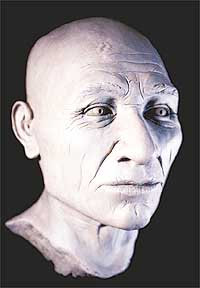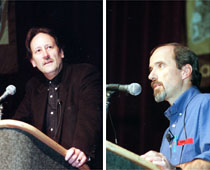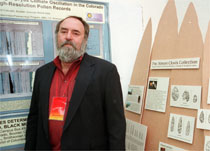 ANTA FE, N.M. -- For most of the 20th century, the solution to the mystery
of the original Americans -- where did they come from, when and how? --
seemed as clear as the geography of the Bering Strait, the climate of the
last ice age and the ubiquity of finely wrought stone hunting weapons known
as Clovis points.
ANTA FE, N.M. -- For most of the 20th century, the solution to the mystery
of the original Americans -- where did they come from, when and how? --
seemed as clear as the geography of the Bering Strait, the climate of the
last ice age and the ubiquity of finely wrought stone hunting weapons known
as Clovis points.
According to the ruling theory, bands of big-game hunters trekked out of Siberia sometime before 11,500 years ago. They crossed into Alaska when the floor of the Bering Strait, drained dry by the accumulation of water in a frozen world's massive glaciers, was a land bridge between continents, and found themselves in a trackless continent, the New World when it was truly new. The hunters, so the story went, moved south through a corridor between glaciers and soon flourished on the Great Plains and in the Southwest of what is now the United States, their presence widely marked by distinctive stone projectile points first discovered near the town of Clovis, N.M. In less than 1,000 years, these Clovis people and their distinctive stone points made it all the way to the tip of South America. They were presumably the founding population of today's American Indians. Now a growing body of intriguing evidence is telling a much different story. From Alaska to Brazil and southern Chile, artifacts and skeletons are forcing archaeologists to abandon Clovis orthodoxy and come to terms with a more complex picture of earliest American settlement. People may have arrived thousands to tens of thousands of years sooner, in many waves of migration and by a number of routes. Their ancestry may not have been only Asian. Some of the migrations may have originated in Australia or Europe. The Clovis-first paradigm "has become increasingly improbable," said Dr. Robson Bonnichsen, an archaeologist at Oregon State University in Corvallis, opening a recent conference here titled "Clovis and Beyond" at which archaeologists looked beyond the shards of old theory in search of new explanations. "Clovis was not the only culture in America 11,000 years ago," Dr. Bonnichsen said.
Two discoveries -- the remains of a pre-Clovis camp at Monte Verde in Chile and the skull and bones of the Kennewick Man, possibly as old as 9,300 years and bearing little physical resemblance to later American Indians -- are primarily responsible for the profound shift in thinking. Freed from the restrictive Clovis model, archaeologists and other scholars have aired a wide assortment of alternative explanations for the initial occupation of America. "Monte Verde puts the peopling of America in a new light," said Dr. David J. Meltzer of Southern Methodist University in Dallas. Two years ago, Dr. Meltzer was a member of a blue-ribbon panel of archaeologists, including some resolute skeptics, who inspected the Monte Verde site, which had been excavated by Dr. Tom D. Dillehay of the University of Kentucky. The visitors took a close look at the stone, wood and bone artifacts, remnants of hide-covered huts and a child's footprint. These were judged to be clear evidence that humans had reached southern Chile 12,500 years ago, more than a millennium before the first signs of Clovis hunters in North America. After years of stout resistance from many establishment archaeologists, the Clovis barrier had finally been breached. Monte Verde was not only the first confirmed pre-Clovis site, but it was nowhere near the Bering Strait and bore little resemblance to the Clovis culture. It seemed time to examine more seriously other migration hypotheses.
Because the ice-free corridor on the eastern flank of the Rockies did not open before 13,000 years ago, and does not appear to have had many plants or animals to feed travelers, many scholars have revived speculation of coastal migration routes. Some of the early people may have come from northeast Asia in hide-covered boats, hugging the southern shore of the Bering land bridge, putting in from time to time for food and water. They could have continued down the west coast of North America long before the glacial corridor was available to them. They could have traveled great distances in relatively short periods, conceivably reaching South America much faster and more easily than by any land routes. Prehistoric people at least as early as the Australian colonists some 50,000 years ago had boats capable of open-sea navigation. Coastal migration is an attractive idea, archaeologists at the conference said, because it could explain the existence of Monte Verde and other possibly pre-Clovis sites in several places in South America and why their cultures, by Clovis times, bore few similarities to North American settlers. Perhaps, Dr. Meltzer said, "there were more, rather than fewer, migratory pulses to the Americas." Establishing a coastal migration was once thought to be hopeless. At the end of the ice age, melting glaciers raised sea levels and inundated what had been ancient shorelines. But recent artifact discoveries off British Columbia, in the Channel Islands off California and along the coast of Peru have bolstered arguments favoring coastal routes as one of many migration theories. "Clovis first and Clovis everywhere was a regional North American phenomenon, and a late one at that," said Dr. Ruth Gruhn of the University of Alberta in Edmonton, reflecting a view long held by a few archaeologists working at South American sites. "North Americans have been discounting South American evidence because it did not fit their models."
Monte Verde also inspired researchers in North America to dig deeper. They have found possibly pre-Clovis remains in South Carolina and Virginia and are beginning to reinterpret findings at the Meadowcroft rock shelter, a site near Pittsburgh. This was how Dr. Albert Goodyear, a University of South Carolina archaeologist, discovered likely pre-Clovis traces at the Topper site near the Savannah River. "I had stopped a little below the Clovis stratum," Dr. Goodyear explained. "You don't look for what you don't believe in. But in light of Monte Verde, I thought, maybe this might be a place to look for pre-Clovis." Increasing evidence of early Clovis, and possibly pre-Clovis, remains in the Eastern United States has raised eyebrows. Perhaps the hunters who came through the ice-free corridor went east first, then moved west. An even bolder idea is attracting debate: perhaps ancestors of the Clovis hunters arrived not by the Bering land bridge, but from Europe by boats skirting the ice of the North Atlantic. Dr. Dennis Stanford of the Smithsonian Institution, a leading proponent of the possible European connection, cited as evidence the stylistic similarities between the stone tools of Clovis and those of the Solutrean culture from Spain and southwestern France, dated from 20,000 to 16,000 years ago. The idea has drawn little support from most archaeologists. But if Monte Verde encouraged thinking about multiple migrations, the discovery of the Kennewick Man, a skeleton found in 1997 in Washington State and dated between 8,000 and 9,300 years old, raised unsettling questions about the origins of the first Americans. Were they all from Asia? Are American Indians actually direct descendants from the first migrants? Early descriptions of the Kennewick skull led to reports that the man was Caucasoid and possibly European. After a more careful analysis, the skull appeared to be longer and narrower than those of modern American Indians. Dr. Joseph Powell of the University of New Mexico reported last month that its physical affinities appeared to be closer to those of South Asians or Polynesians than either Europeans or American Indians. At the conference, Dr. Douglas Owsley of the Smithsonian Institution and Dr. Richard Jantz of the University of Tennessee at Knoxville reported that close examination of the craniums of several other skeletons and mummies found in the Americas produced similar results. The evidence, they said, suggested that either more than one group of people migrated into the New World or the settlers underwent significant physical changes in the time after their arrival. It is even possible that the first migrants became extinct, replaced by subsequent groups. The issue is central to a legal case pitting American Indians, who claim Kennewick Man as an ancestor and want his remains turned over to them for reburial, and anthropologists, who are seeking access to the skeleton for more detailed studies, including DNA tests of the man's genetic background. Another skeleton, of a woman being called Luzia, which was found in Brazil, has prompted speculation of another origins scenario. The skeleton, estimated to be possibly 11,500 years old and thus older than any previous human bones in the Western Hemisphere, appeared to be more Negroid in its cranial features than Mongoloid. Dr. Walter Neves of the University of São Paulo said this suggested that some of the first people in South America might have originated in Australia, or at least South Asia. Last month, he said Luzia might have belonged to a nomadic people who began arriving in the New World as early as 15,000 years ago. They may have come across the Pacific, but more probably, he said, they were a branch of Southeast Asians, some of whom settled in Australia as the Aborigines while others navigated northward along the Asian coast and then across the Bering Strait. It may be a long time before the shattered Clovis-first hypothesis is replaced by a single new paradigm. In the meantime, some Clovis partisans are not giving up without a fight. In the current issue of the magazine Scientific American Discovering Archaeology, Dr. Stuart J. Fiedel of John Milner Associates in Alexandria, Va., which conducts archaeological excavations under contract, said that Dr. Dillehay's Monte Verde report was riddled with errors and omissions that "raised doubts about the provenience of virtually every" artifact excavated there. Monte Verde, he concluded, "should not be construed as conclusive proof of a pre-Clovis human occupation in South America." Dr. C. Vance Haynes Jr. of the University of Arizona, one of the staunchest defenders of the Clovis orthodoxy, said that, though he had been a member of the panel of experts that authenticated Monte Verde's pre-Clovis credentials, he now had serious second thoughts. After further study of the evidence, he said, "To my surprise, I found these data to be inadequate and therefore unconvincing." The attack on Monte Verde, published just before the conference here, raised cries of foul. Many archaeologists complained that Dr. Fiedel's review was biased and ignored material that did not support his critical thesis. They deplored his tactic of airing his critique in a popular magazine rather than a peer-reviewed journal. In a defense of Monte Verde, also published in the magazine, Dr. Dillehay acknowledged that some errors had crept into the 1,300-page report and would be corrected, but none of them undercut an interpretation of the place where pre-Clovis hunter-gatherers camped 12,500 years ago. At the conference, he called Dr. Fiedel's review "ungrounded accusations" and one more example of North American archaeologists' dismissal of South American sites because they lacked the familiar Clovis stone-tool technology. "The half-century-long emphasis on Clovis projectile points and related durable lithic artifacts," argued Dr. James M. Adovasio of Mercyhurst College in Erie, Pa., who excavated the long-disputed Meadowcroft site and thus sees himself as another victim of Clovis chauvinism, "has actually served to mask rather than elucidate the nature of late ice age adaptations in the New World." Warming to the attack, Dr. Adovasio charged that evidence of "soft technologies" such as cordage, netting and basketry was seldom given its due at many early American sites. The result, he said, was a failure to appreciate fully the way of life of the first American colonizers. "Nets suggest a subsistence strategy carried out by both sexes and all age groups in stark contrast to the traditional model based on highly mobile groups of spear-wielding, mammoth-killing macho men," Dr. Adovasio said to another round of hearty applause. The loss of a paradigm has thus plunged American archaeology into a new period of tumult and uncertainty over its oldest mystery, one critical to understanding how modern humans spread out through the world. For their entry into America was the last time in history when people occupied an entirely new land, alone and with little more than their own ingenuity and an eye on far horizons. "We're going to have to open our minds," Dr. Michael B. Collins of the University of Texas said at the conference. "We're going to have to explore some ideas that may not get us very far. We're going to have to be tolerant of each other as we explore these ideas. My God, this is an exciting time to be involved in research in the peopling of America and the earliest cultures of the Americas." |



